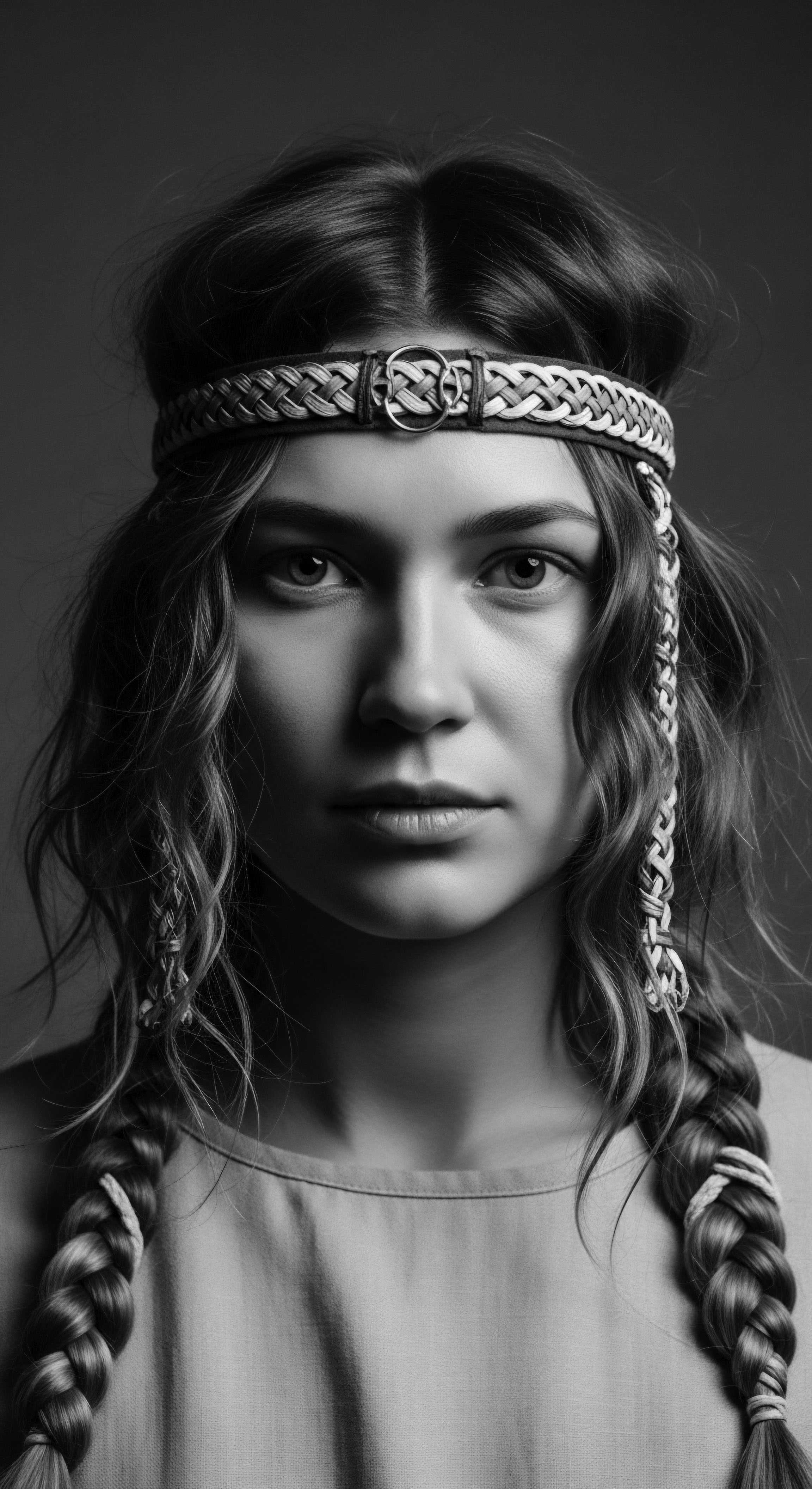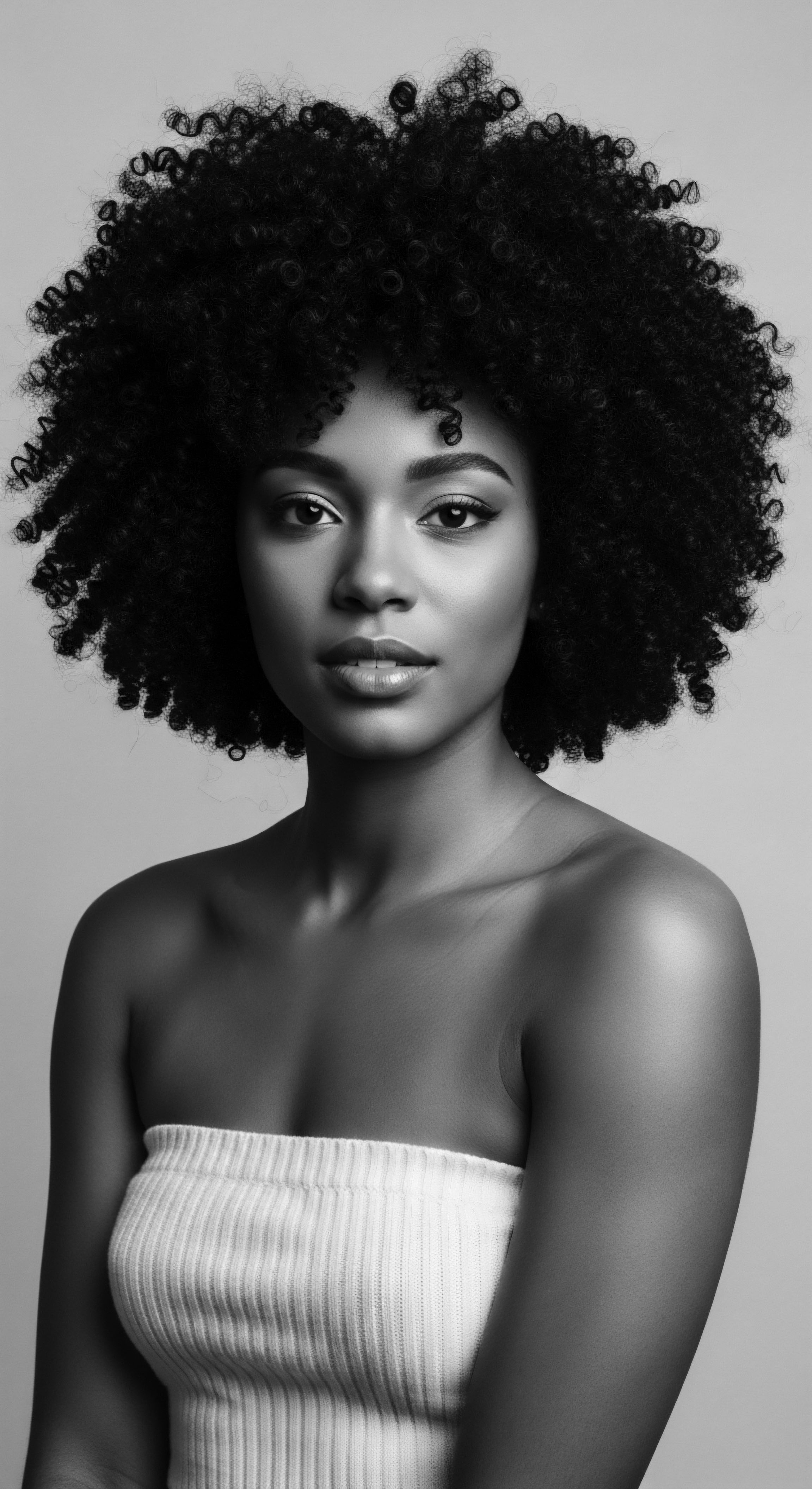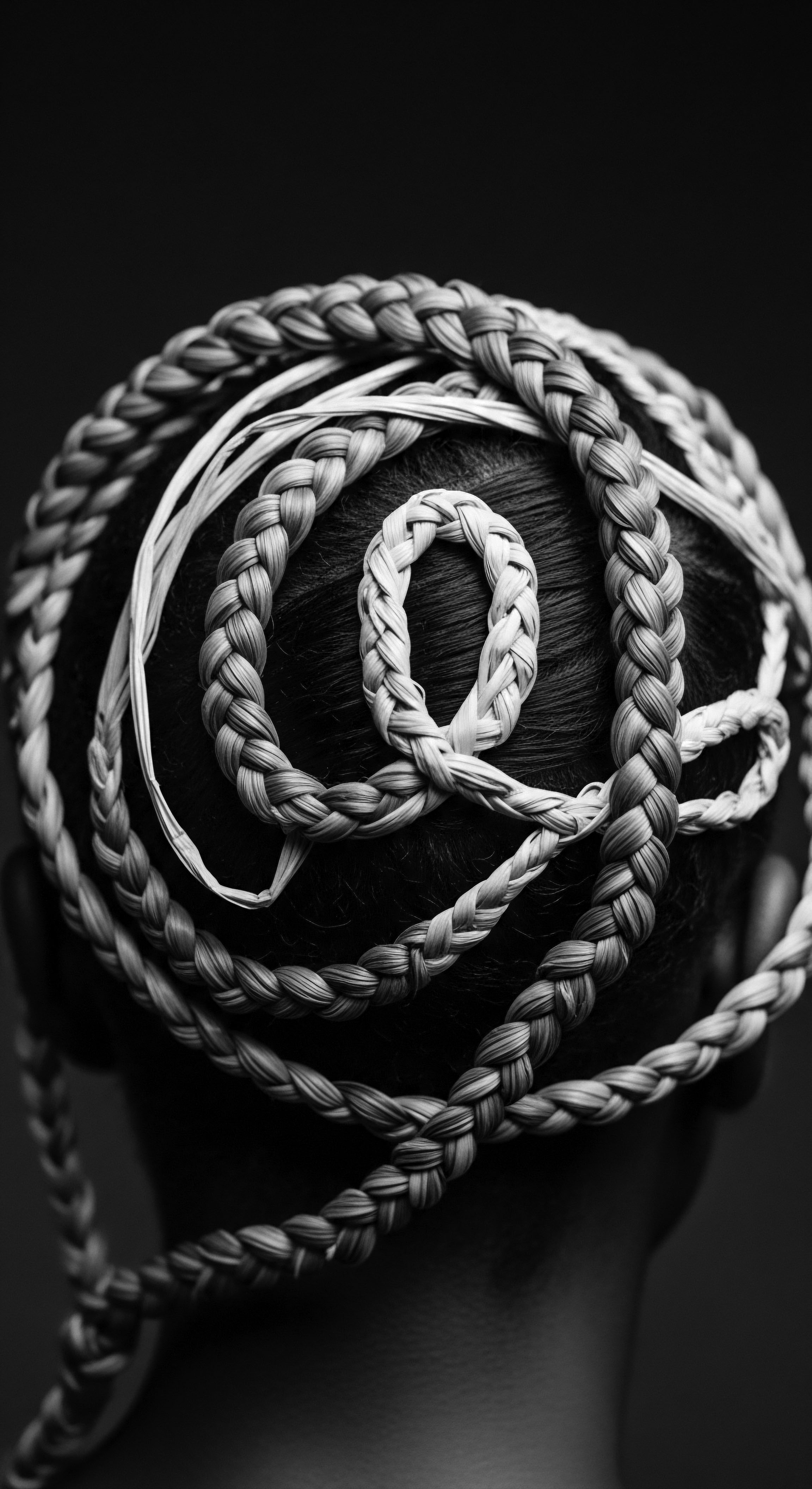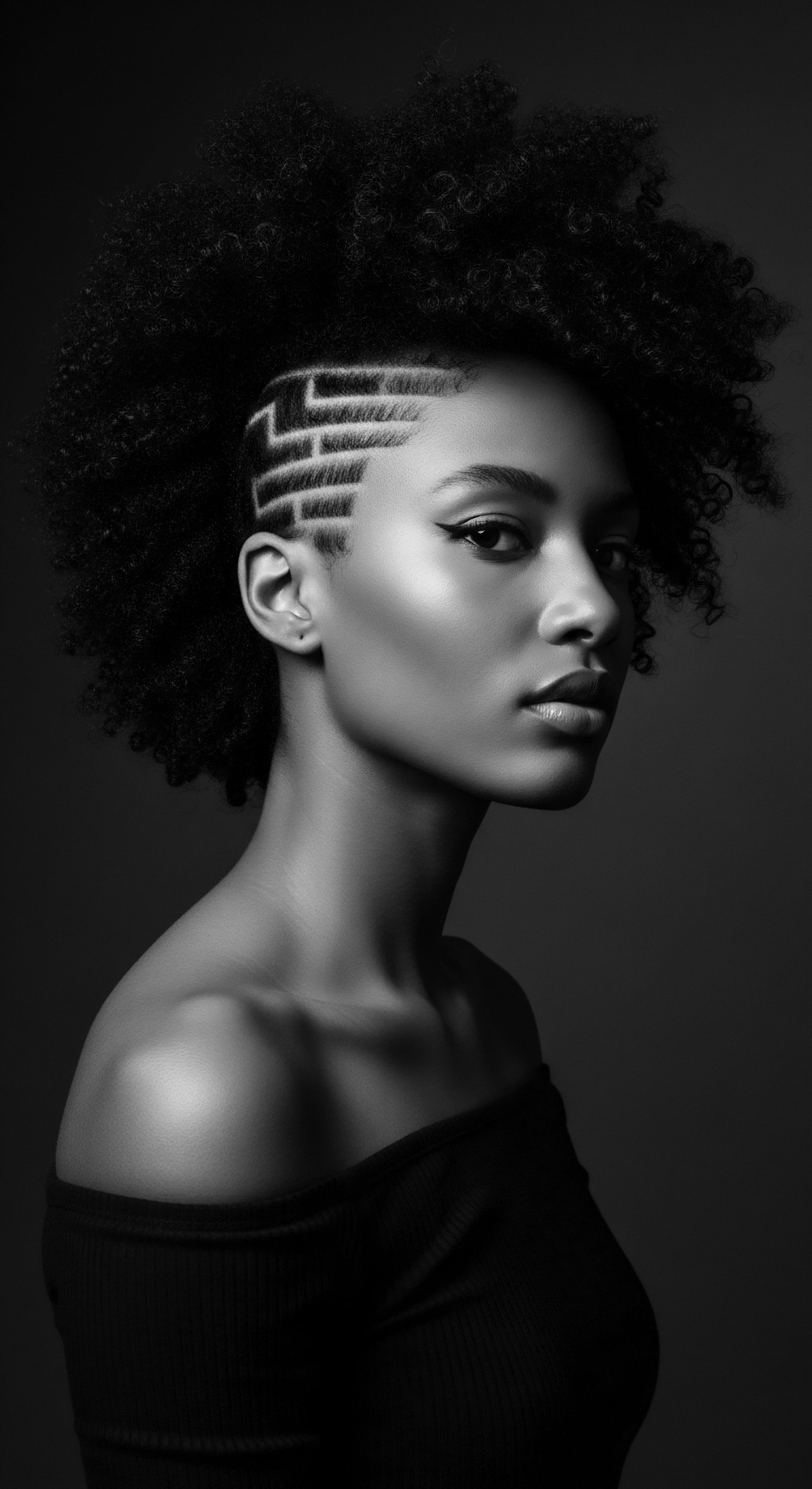Our hair, in its countless textures and coils, carries stories etched across time, whispering truths about heritage. The way we tend to it, the ingredients we seek out, these are not mere choices of aesthetics. They are echoes of a deep ancestral wisdom, a continuation of practices born from intimate observation and profound respect for the natural world.
To understand how our ancestors selected oils for textured hair is to trace a lineage of care, a legacy of ingenuity that speaks to survival, identity, and profound connection to the earth beneath their feet and the sky above their heads. This exploration is a testament to the enduring spirit of textured hair heritage, a living archive we continue to write.

Roots
Consider a strand of textured hair. Its helix, a marvel of biological design, speaks to resilience, to an ability to defy gravity and hold form. This intrinsic structure, often characterized by its elliptical cross-section and numerous bends, naturally presents unique needs for moisture retention and protection. Our ancestors, acutely aware of their environment and the plants it offered, perceived these needs not through a microscope, but through the keen eye of sustained observation.
They watched how the sun dried the earth, how certain leaves retained dew, how fruit yielded its essence. These observations guided their early selections, forming the very foundation of textured hair care, a heritage passed through generations. They understood the hair’s propensity for dryness, its desire for protection against the elements ❉ scorching sun, dry winds, and the ever-present dust of daily life.

What Did Early People Notice About Their Hair and Environment?
The dawn of human ingenuity in hair care was not a sudden revelation, but a slow, deliberate accumulation of knowledge. Early peoples lived in an unmediated relationship with their surroundings. They learned what soothed skin, what offered protection from insects, what lent pliability to fibers. This empirical wisdom extended to their hair.
For those with coils and curls, hair could be a protective crown or a challenge, depending on its state. Hair that felt brittle, broke easily, or appeared dull signaled a need. The observation of natural oils, perhaps from the rendering of animal fats or the pressing of plant seeds, would have revealed their emollient properties, their ability to coat, soften, and impart a subtle sheen. This was the nascent understanding of a hair shaft’s needs, interpreted through the language of survival and daily living.
Think of the arid landscapes of certain African regions or the sun-drenched plains where Indigenous communities thrived. Here, maintaining moisture was not a cosmetic preference but a practical necessity for bodily well-being, extending to the hair. The very environment shaped the initial selection.
Oils that offered a barrier against moisture loss, oils that cooled the scalp, oils that felt substantial enough to protect were likely prioritized. This ancestral selection process was a direct dialogue with nature, a conversation where the needs of the hair found answers in the bounty of the land.
Ancestral selections of hair oils were born from keen observation, a deep environmental connection, and an understanding of textured hair’s intrinsic need for moisture and protection.

How Did Ancestors Discern Suitable Plant Qualities?
The discernment of suitable plant qualities came from a place of intimate knowledge, often gained through trial and error over countless generations. A plant that yielded a rich, unctuous substance when its seeds were pressed, or a fruit whose pulp felt lubricating, would immediately draw attention. For instance, the shea tree, native to West Africa, produces a fruit whose nuts yield a rich butter. This substance, known as shea butter, has been used for centuries to protect skin from harsh sun, wind, and dust, and to nourish and moisturize hair.
Its widespread acceptance was not due to chemical analysis, but to its palpable effects ❉ hair felt softer, more manageable, less prone to breakage. This was an observed, lived science.
Similarly, the baobab tree, often called the “Tree of Life” in the African savannah, yields seeds from which baobab oil is extracted. This oil, rich in omega fatty acids and vitamins, was found to be an excellent conditioner, helping to moisturize dry, brittle hair and reduce frizz. The connection between a plant’s observable properties and its benefit to hair would have been established through consistent use and shared community knowledge. The wisdom was not codified in texts, but in communal practice and oral tradition, in the careful instruction from elder to youth.
The practices were often holistic, recognizing that health flowed from the inside out. Therefore, ingredients used for internal wellness might also be considered for external application. If a plant was known for its healing properties for the body, it might also be applied to the scalp, viewed as an extension of the skin. This understanding reflects a fundamental approach to well-being that predates modern distinctions between medicine and cosmetics.
- Shea Butter ❉ Extracted from the nuts of the shea tree, its long history in West Africa speaks to its observed moisturizing and protective qualities, especially vital in dry climates.
- Baobab Oil ❉ From the seeds of the African baobab tree, this oil’s traditional use for conditioning reflects its rich content of fatty acids, recognized for softening hair.
- Palm Oil ❉ Sourced from the palm fruit, its use in various African regions for centuries suggests its recognized ability to hydrate and provide a protective coating for the hair.
The sheer efficacy of these natural substances meant their use persisted. Their selection was a pragmatic choice rooted in observable benefit. When hair felt good, looked healthy, and was easier to manage, the choice of oil was affirmed. This was the foundation of a care system deeply connected to the land and the needs of textured hair, a system that valued tangible results over abstract chemical compositions.
| Observed Plant Characteristic Yields unctuous, creamy substance from nut or seed |
| Ancestral Selection Rationale Offers substantial coating and moisture retention for coils |
| Perceived Hair Benefit (Heritage Link) Reduces breakage, softens texture, improves manageability of natural coils |
| Observed Plant Characteristic Provides liquid, light consistency oil |
| Ancestral Selection Rationale Absorbs readily, adds luster without heavy residue |
| Perceived Hair Benefit (Heritage Link) Enhances shine, protects strands from environmental factors |
| Observed Plant Characteristic Possesses a pleasing aroma or cleansing property |
| Ancestral Selection Rationale Contributes to overall well-being, addresses scalp discomfort |
| Perceived Hair Benefit (Heritage Link) Soothes scalp, reduces irritation, refreshes the hair and head |
| Observed Plant Characteristic Ancestral oil selection was a pragmatic system, aligning observable plant properties with the specific needs of textured hair and scalp health. |

Ritual
The application of oils for textured hair by our ancestors was rarely a solitary, utilitarian act. It was often imbued with ritual, a communal practice that spoke to far more than mere conditioning. These were moments of connection ❉ with family, with community, with ancestral knowledge, and with the very essence of self. The tender touch of hands working oil through coils, the rhythmic braiding that followed, these acts created a tender thread binding generations and solidifying the cultural significance of hair care.
This deeply embedded practice forms a significant part of textured hair heritage, a living legacy that resonates even today. The warmth of the hands, the murmur of stories, these elements transformed oiling from a simple task into a sacred ritual.

How Did Hair Oiling Become a Communal Practice?
Hair care in many traditional Black and mixed-race communities was inherently communal. It was not something typically performed in isolation, but rather a shared experience, often among women. Young girls learned from their mothers, grandmothers, and aunties, observing the methods, feeling the textures, and absorbing the wisdom that accompanied each application of oil. This oral and tactile transmission of knowledge ensured that practices were preserved, adapted, and passed down.
The act of oiling a child’s hair, for instance, became a moment for storytelling, for imparting lessons, for bonding. These shared moments solidified communal ties and reinforced identity. The communal aspect transformed hair care into a deeply social and cultural institution. This tradition, where elders massaged oil into the scalps of younger family members, served as a ritual of both hair care and bonding.
Consider the significance of hair in various African cultures, where it is often considered a bridge between the living and the ancestral world. Specific rituals were performed with hair, sometimes involving oils, before significant life events such as birth, marriage, or death. In Yoruba culture, for example, hair is associated with the Orishas, deities, and women’s hair was styled in elaborate braids to honor these spiritual figures. The application of oils would have been an integral part of preparing the hair for these symbolic styles, ensuring its pliability and health, and contributing to the spiritual purpose of the ritual.
The practice also served as a means of collective self-expression and cultural affirmation. As Sybille Rosado suggests, hair and hairstyles among women of African descent are evidence of rituals practiced across the diaspora, highlighting the socio-cultural role hair maintains among Black people. The shared understanding of particular oils and their uses became part of a collective identity, a silent language spoken through the sheen of a well-oiled braid or the softness of a nurtured coil.

What Specific Oils Supported These Heritage Practices?
The choice of oils was deeply regional and resource-dependent, yet certain ones emerged as staples due to their effectiveness. In West Africa, shea butter became a cornerstone, its production and trade often linked to women, earning it the alias “women’s gold”. It was applied to moisturize and protect hair, particularly against harsh environmental conditions. Its rich, creamy texture would have been ideal for sealing in moisture on textured hair.
Red palm oil, sourced from the palm fruit, was another significant oil in various African regions, known for its emollient properties, its ability to cleanse, condition, and add shine, and its potential to protect hair from irritation. Its vibrant color also held cultural appeal.
For some Indigenous communities in North America, oils derived from local flora and fauna were central. The Huron and Sauk tribes, among others, valued bear grease for its versatility in styling and its cultural significance as a symbol of strength and connection to nature. Raccoon fat, fish oil (from fatty fish like salmon), and deer marrow were also used for their conditioning properties. The Cheyenne, for instance, used wild mint to create an antibacterial hair oil, while other tribes used yucca roots for natural shampoos that protected against dandruff and hair loss.
These choices reflect a profound understanding of their immediate environment and the specific benefits offered by its resources. These practices were not simply about aesthetics; they were ingrained in the cultural fabric of indigenous communities, showing their deep relationship with nature and sustainable resource use.
Castor oil, originating in ancient Egypt and Africa, traveled with enslaved people during the transatlantic slave trade and became integral to traditional beauty and medicine in places like Jamaica. Its thick consistency would have been recognized for its ability to coat and protect hair strands, making it suitable for textured hair types prone to dryness and breakage. This oil exemplifies how ancestral knowledge, though displaced, survived and adapted in new geographies.
- Shea Butter ❉ A rich, creamy butter from West African shea nuts, it consistently provided superior moisture and protection for textured hair, becoming a vital part of cultural traditions.
- Palm Oil ❉ Extracted from the palm fruit, this oil, often red, was valued across Africa for its cleansing, conditioning, and protective qualities, contributing to hair health and sheen.
- Castor Oil ❉ With its ancient origins in Egypt and Africa, this thick oil, particularly Jamaican Black Castor Oil, gained prominence in the diaspora for its robust moisturizing and strengthening benefits.
- Animal Fats (e.g. Bear Grease, Deer Marrow) ❉ Utilized by various Indigenous North American tribes, these fats offered substantial conditioning and protection against environmental factors, rooted in hunting and reverence for the land.
| Traditional Oil Shea Butter |
| Geographical Heritage West Africa |
| Ancestral Rationale for Selection Provides intense moisture and protection against dry climates, culturally revered as "women's gold". |
| Traditional Oil Red Palm Oil |
| Geographical Heritage Various African regions |
| Ancestral Rationale for Selection Offers substantial emollient and cleansing properties, contributing to hair health and vibrant appearance. |
| Traditional Oil Castor Oil |
| Geographical Heritage Ancient Egypt, Africa, Caribbean |
| Ancestral Rationale for Selection Known for its thick texture that coats and strengthens hair, helping with moisture retention and perceived growth. |
| Traditional Oil Bear Grease |
| Geographical Heritage Indigenous North America |
| Ancestral Rationale for Selection Valued for its conditioning effects, protection from elements, and deep cultural connection to land and animal. |
| Traditional Oil These oils were selected for their tangible benefits and also for their deeper cultural and symbolic roles within ancestral hair care rituals. |
The continuity of these practices, even across vast distances and through profound historical disruptions, speaks to their enduring value. The communal hair rituals, centered around these carefully chosen oils, fortified bonds and preserved a heritage of care that persists today. They remind us that hair care, for our ancestors, was a celebration of life, community, and identity.

Relay
The wisdom embedded in ancestral oil selection for textured hair did not vanish with the passage of time. Instead, it was relayed, carried forward like a precious torch across generations and continents, adapting, yet retaining its core truth. This relay of knowledge, often through oral tradition and lived example, speaks to the resilience of cultural practices and the profound heritage of textured hair care.
It reveals how ancient understanding meets modern insight, confirming the empirical observations of our forebears with the language of science. This ongoing dialogue between past and present allows us to comprehend the enduring power of these time-honored practices.

How Do Ancient Observations Align with Modern Science?
The effectiveness of many traditionally used oils, once understood solely through observation and experience, now finds scientific validation. Ancestors may have noticed that certain oils made hair softer, less prone to breakage, or appeared to promote growth. Modern scientific analysis has begun to explain the chemical compositions behind these observed benefits.
For instance, the high content of fatty acids in many plant-derived oils—such as palmitic, stearic, oleic, and linoleic acids—contributes significantly to their emollient and moisturizing properties. These fatty acids can coat the hair shaft, reducing water loss and helping to smooth the cuticle, thereby decreasing frizz and increasing shine.
Consider Coconut Oil, a staple in Ayurvedic practices for thousands of years. Its traditional use for nourishing the scalp and strengthening hair aligns with modern understanding of its high lauric acid content. This particular fatty acid can penetrate the hair shaft, reducing protein loss during washing and grooming, which is particularly beneficial for textured hair, which can be more susceptible to protein loss and breakage.
Similarly, the use of Castor Oil in ancient Egypt and its subsequent journey to the Caribbean, where it became a foundational element of Jamaican Black Castor Oil, was likely due to its thick consistency. Scientific analysis confirms that ricinoleic acid, a primary component of castor oil, imparts moisturizing and nourishing qualities that help seal moisture into strands.
The practice of using oils for scalp health also finds resonance in contemporary understanding. Oils rich in antioxidants, such as Marula Oil from Southern Africa or Black Seed Oil, used across North Africa and Southwest Asia, were likely valued for their soothing effects. Modern research shows these oils contain compounds that possess anti-inflammatory and antimicrobial properties, helping to address scalp irritation, dandruff, and create an environment conducive to healthy hair growth.
For instance, a 2013 study found that 70% of women using black seed oil experienced significant improvements in hair density and thickness after three months, supporting its traditional use for hair growth and scalp health. This example powerfully illuminates the direct connection between ancestral observation and modern scientific validation, demonstrating how heritage informs contemporary understanding.
The ancestral selection of specific oils, once guided by observation, is now frequently affirmed by scientific analysis of their beneficial fatty acid profiles and antioxidant properties.
This validation strengthens the heritage narrative, showing that the wisdom passed down was not merely folklore but a practical, effective system of care developed through deep empirical engagement with natural resources. The historical consistency in the use of certain oils across diverse cultures, from the shea belt of West Africa to the Indigenous lands of North America and the Ayurvedic traditions of India, points to a shared recognition of their intrinsic value for hair.

How Has Hair Care Become a Statement of Cultural Affirmation?
Beyond their physical benefits, oils and the rituals surrounding their application hold profound cultural and political significance within Black and mixed-race communities. For centuries, textured hair has been a site of both beauty and struggle, deeply intertwined with identity and resistance. Colonialism and slavery often brought attempts to suppress ancestral hair practices and devalue natural hair textures, aligning beauty standards with Eurocentric ideals.
In response, the continuation of traditional hair care, including the use of ancestral oils, became an act of defiance, a quiet reclaiming of heritage and self. The natural hair movement, which has gained significant traction, is a contemporary manifestation of this historical resistance.
Choosing oils like shea butter or coconut oil, and adopting protective styles that honor the hair’s natural form, serves as a conscious connection to a lineage of care that predates imposed standards. This is not just about aesthetics; it is about self-acceptance, cultural pride, and community solidarity. As Sybille Rosado suggests, the maintenance of hair grooming practices and African aesthetics throughout the diaspora is anthropologically relevant due to the socio-cultural role hair plays among Black people.
The decisions made about hair are imbued with meaning beyond simple choices of appearance. For many Black women, for instance, choosing natural indigenous oils like jojoba became an act of resistance against Eurocentric beauty ideals, aligning with a broader embrace of cultural authenticity during the 1970s Black is Beautiful movement.
The transmission of knowledge about these oils from mother to daughter, grandmother to grandchild, becomes a powerful form of cultural relay. It ensures that the legacy of self-care, resilience, and beauty endures. This continuity helps individuals connect to their roots, affirming their identity in a world that often seeks to homogenize.
The very act of selecting and applying these traditional oils becomes a small, yet significant, ritual of remembrance and affirmation. This deep connection to heritage serves as a beacon, guiding individuals toward a deeper appreciation of their hair’s unique story.
The journey of textured hair care, from ancient forests to modern wash days, is a testament to the ingenuity of our ancestors. Their intuitive understanding of plant properties, honed through generations, laid the groundwork for practices that continue to nourish, protect, and empower. The oils they selected were not just products; they were conduits of care, tradition, and an enduring connection to heritage.

Reflection
The lineage of textured hair care, stretching back through the mists of time, stands as a testament to profound human ingenuity and the enduring spirit of heritage. It is a story told through the careful hands of ancestors, through the rustle of leaves, the pressing of seeds, and the gentle touch of oil upon coil. The selection of oils for textured hair, a practice so deeply embedded in Black and mixed-race experiences, offers more than a lesson in historical botany; it provides a living archive of resilience, cultural preservation, and a sacred connection to self. Each strand, each curl, holds within it the memory of generations who understood their hair as an extension of their identity, a crown to be honored, and a canvas for cultural expression.
In every drop of shea butter, in the sheen of palm oil, in the rich viscosity of castor oil, we find echoes of ancient wisdom. This wisdom was not born of formal laboratories, but from a profound attunement to the rhythms of the earth, from observing, experimenting, and passing down the knowledge of what truly nourished. This heritage of care, tested by time and carried across vast oceans, remains a vibrant force today.
It calls us to recognize the deep scientific truths hidden within traditional practices and to value the cultural narratives that give them meaning. To care for textured hair with these ancestral oils is to participate in a timeless conversation, to honor a legacy of strength and beauty, and to claim a heritage that continues to shape who we are.

References
- Abegunde, O. (2018). African Philosophy of Hair. Adetutu Omotoso.
- Byrd, A. D. & Tharps, L. L. (2014). Hair Story ❉ Untangling the Roots of Black Hair in America. St. Martin’s Griffin.
- Leach, E. R. (1958). Magical Hair. Journal of the Royal Anthropological Institute of Great Britain and Ireland, 88(2), 147-164.
- Rosado, S. (2003). The Politics of Black Hair ❉ From the African Diaspora to the United States. University of California Press.
- Sushruta. (6th century BCE). Sushruta Samhita. (Various editions and translations).
- Zeleza, P. T. (2005). The African Diaspora ❉ A History Through Culture. Indiana University Press.
- Komane, B. M. et al. (2017). Adansonia digitata L. (Baobab) seed oil ❉ A comprehensive review of its traditional uses, nutritional value, and potential for cosmetic and pharmaceutical applications. Journal of Ethnopharmacology, 203, 169-178.
- Wallace, J. (2020). Hair ❉ A Cultural History. Bloomsbury Academic.
- Banks, I. (2000). Hair (Self) Love ❉ Black Women’s Hair Journeys and the Politics of Identity. Temple University Press.
- Rosado, S. (2007). Hair Politics ❉ Black Women’s Hair in the African Diaspora. Peter Lang.
